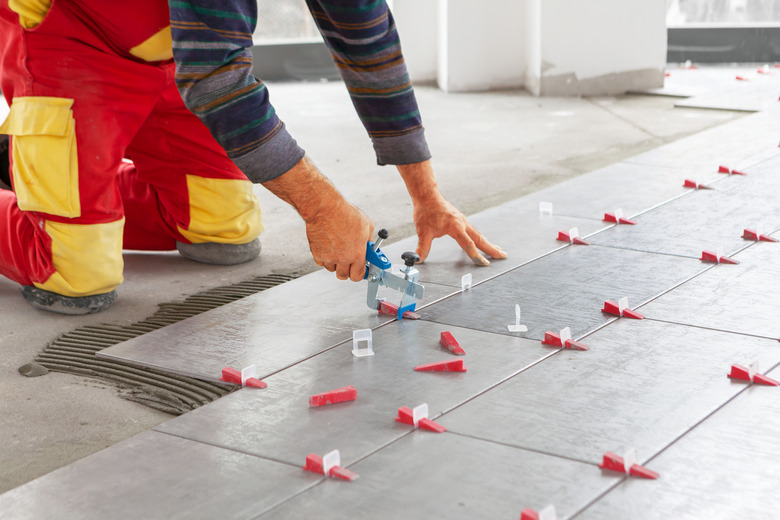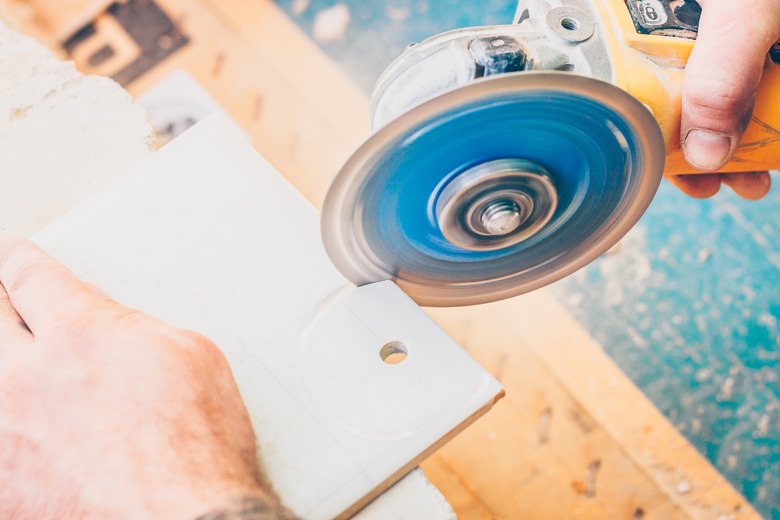How To Cut Tile
Many DIY home improvement projects require learning how to cut tile. Installing a backsplash? A new floor? You may need this skill. Porcelain and ceramic tile are two of the most popular choices, but stone, mosaic tile and glass tile are also fairly common materials. Tiling projects can be completed manually or with the use of power tools depending on factors such as budget, difficulty and the material that is chosen.
Choosing Tile, Layout, and Tools
Ceramic tiles are very easy to work with, and most DIY projects that use this material can be executed with only basic tools if the job isn't too large. The Tile Council of North America points out that porcelain tile is harder and more difficult to cut, making it a good candidate for a tile saw. Glass and mosaic tiles also require a bit more care to make sure they don't chip or break when cutting.
Tile layout is an important step when it comes to knowing what cuts will need to be made for any tile job, small or large. According to the Ceramic Tile Education Foundation, some time should be taken to arrange the tiles in a way that will minimize small pieces and excessive tile cutting while still being centered.
Manual tiling tools like snap cutters and tile nippers are less expensive but may require some extra time and effort. Power tools such as a wet saw and angle grinder can provide a more professional result but may be overkill for smaller projects. It's best to choose tools that are priced right for the job and that cut through the tile most effectively.
The Tile Cutting Process
No matter what type of material is chosen, tile cutting can be broken down into several basic steps. First, you will need to mark the tile where it needs to be cut based on your overall measurements and layout. After that, you will score and cut the tile along that line using either a manual tile cutter or a tile saw. For special cuts like curves or circles, you may need other tools, like an angle grinder or tile nippers to cut tile. The final step is evaluating the edges of the tiles to make sure they are smoothed out and ready for installation.
For best results, always select the blade or tool that is designed for the type of tile you will be cutting. There are specialized manual glass cutters, diamond tile saw blades and other material-specific options. In addition, there are different tiling tools for straight cuts and curved cuts or circles. Choosing the right one for the job is key to overall success.
No matter what tool you are going to use to cut tile, it's smart to practice on a few sample pieces. This will help you get a feel for the system, the amount of pressure you'll need and other procedural details.
Cutting Tile With a Wheel Cutter or Snap Cutter
You can make your straight cuts manually by using a tile cutter wheel (or tile scribe) or by using a snap tile cutter. The process is similar for both methods, but using the snap tile cutter may be more efficient for larger tiling jobs. Always be sure to wear safety gear such as goggles and gloves when cutting tile.
- Measure and mark the cuts with a pencil
or nonpermanent marker. - Score the tile along the line with your cutter wheel or snap tile cutter. Use firm pressure and only make one pass. Do not press too hard, or you may snap the tile.
- Use the bar of the snap cutter from above the scored line and press down firmly to snap the
tile. You can also use specialized pliers or cutters to complete the cut if it is a
smaller area or a small tile. - Smooth any jagged areas with a rubbing stone designed for the specific material you are using.
Cutting Tile with Tile Nippers
Tile nippers are often used for curved manual cuts. This tool is best used for smaller cuts, as it can be labor intensive. Make sure you are wearing safety equipment for this task, as nippers can cause tile pieces to go flying when cut.
- Measure and mark cuts with a pencil or nonpermanent marker.
- Score the tile along the line with a cutter wheel or tile scribe.
- Use the tile nippers to take off very small pieces from the tile until the cut is complete.
- Smooth any jagged areas with a tile stone as needed.
Cutting Tile With a Wet Saw
A wet saw is generally the tool of choice for materials such as stone and harder porcelain tiles. If you don't want to buy one, you can rent one at your local home improvement store.
Make sure the blade is specific to the material you are cutting. For example, glass tiles require a finer diamond blade for cuts so the edges don't chip. It's worth investing a few dollars in the right blade for the job. Also, be sure to put on eye and hearing protection as well as nonslip shoes and gloves before cutting.
Prior to making any cuts, fill the pan/reservoir with water and check to be sure the water will be in contact with the blade. This keeps the wheel (and tile) from overheating and causing damage.
- Measure and mark the cuts with a pencil or nonpermanent marker.Line up your marks while positioning the tile directly against the fence and turn on the power. Make sure the water is in contact with the spinning blade and give the machine a few moments to reach full speed
- Set the tile onto the sliding bed of the saw so your cutting line is aligned with the saw blade.
- Hold the tile firmly in place with two hands, one at either side of the blade. Slowly slide the bed forward to engage the tile into the blade, and continue pushing until the cut is complete. Be sure not to force the tile into the blade and be very careful to keep your hands away from it while the saw is running.
- Pull the tile pieces away from the saw, being careful not to touch the blade.
- Turn off the saw and let it come to a complete stop before setting up for the next cut.
Cutting Tile With an Angle Grinder
An angle grinder is a great tool for making curved cuts. You can rent one from a local home improvement store if you don't own one. In addition to safety equipment, be sure to wear a mask for this type of cut, as it creates a lot of dust.
- Measure and mark cuts with a pencil or nonpermanent marker.
- Score along the line with a cutter wheel or tile scribe.
- Clamp the tile to a table prior to making the cut.
- Make sure the tool guard is set properly and turn on the angle grinder.
- Slowly and carefully make your cut, making as many passes as needed.



